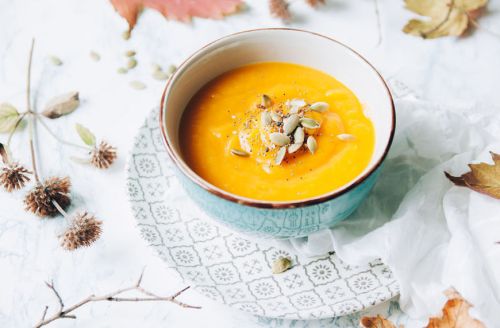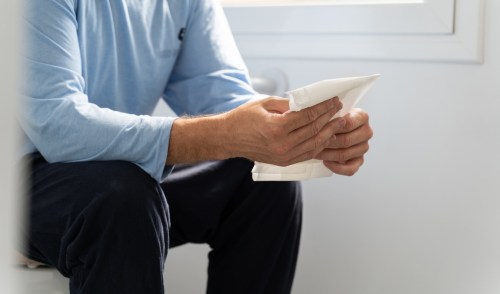Most of us think of “damp” and “dry” in terms of how recently we used our bath towels, or what the weather is doing outside. But according to the 2,500-year-old school of thought of traditional Chinese medicine (TCM), there’s so much more to these concepts than what’s going on outside the body.
Experts in This Article
doctor of Chinese medicine and founder of YinOva Center
doctor of natural medicine, chiropractor, and clinical nutritionist
acupuncturist, herbalist, and founder of Vie Healing
“The idea of internal dampness versus dryness in traditional Chinese medicine refers to the specific ways that what you eat affects your overall internal balance,” explains Josh Axe, D.N.M., C.N.S., D.C, author of the upcoming book, Keto Diet (Feb 2019) and co-founder of Ancient Nutrition. (Dampness and dryness are two of the six the “pernicious influences” in TCM that are believed to affect your body’s balance and cause illness and disharmony—along with heat, cold, wind, and summer heat.) After being eaten and digested, some foods create an environment of dampness while others create an environment of internal dryness, Dr. Axe says.
As for what that means (as well as the rationale behind your BFF’s new “anti-dampness” diet)…more on that below.
What is “dampness?”
The TCM approach suggests that there are certain foods that make our internal systems “damp”, or phlegmy, clammy, sluggish, swollen, groggy, or cold , says Jill Blakeway, DACM, a doctor of Chinese medicine and Well+Good Council member. “These symptoms start in the digestive symptom and spleen, and then accumulate and bring stagnation to the rest of the body.” Stagnation translates into things like unwanted weight gain, bloating, low energy, loose stools, and phlegm-y lungs, she says. She adds an excess of dampness is believed to contribute to yeast infections, joint inflammation, cystic acne, and sinus infections.
While some people are genetically more prone to it than others, Dr. Blakeway says that the main culprit of excessive dampness is diet. (Although other factors like limited physical activity, and the climate where you live can also increase the likeliness of dampness, she says.)
OK, so what does it mean to be “dry”?
Dampness comes with so many “thank u, next” downsides that it’s easy to assume that dryness is better. But don’t get it twisted. “Dryness is the other side of dampness, but for our bodies to function properly, we need to maintain homeostasis—which is somewhere in the middle,” explains Dr. Axe. (For the people in the back: Everything in moderation!)
“In TCM, an excess of dryness is considered a yin deficiency. It’s a form of overheating,” says Dr. Blakeway. Think about it like this: Leaves dry out and shrivel up when exposed to too much heat. According to TCM, the same thing can happen inside our bodies. She says signs of excessive dryness can include dry hair, dry eyes, dry skin, night sweats, vaginal dryness, sweaty hands and feet, chapped lips, acid reflux, low estrogen, and constipation.
As with dampness, some people have a higher propensity to become dry than others—based on factors such as genetics and the climate where you live—but it’s something anyone can become. “It’s rare for Americans to suffer from dryness. But it becomes more common as we get older,” says Dr. Blakeway.
Damp vs dry foods: how to tell which is which
According to all the experts I spoke to, diet can have the biggest impact on whether you’re overly dry or damp. “Foods have their own texture or nature,” says Vie Healing founder Mona Dan, an acupuncturist, herbalist, and TCM expert. Usually, you can guess if a food is damp or dry by thinking about the food’s consistency, she says. “For example: Cheese is damp. Chips are greasy and damp. Bananas and egg yolks are really damp.”
According to Dr. Axe, the list of damp-inducing foods includes anything made with refined sugars or sugar substitutes, wheat products, baked goods and cereals, dairy products (especially milk, cream, and cheese), processed foods, and fatty meats. The way you cook your foods can affect its damp-o-meter, too. “Foods served cold or raw are also very damp-inducing,” says Dr. Blakeway.
On the other end of the spectrum, traditionally “dry” foods include whole grains like brown rice and oatmeal, beans and lentils, animal meat, roasted vegetables, nuts and seeds, as well as anything spicy, says Dr. Axe.
Finding balance
Ultimately, when it comes to dampness and dryness, the goal is to be neither. Or as Blakeway says, “In middle is good health and balance”.
To do that: “First, you need to first address your patents of disharmony,” Dr. Blakeway says (aka figuring out whether or not you run dry or damp). “Because a TCM diagnosis can be quite complex, it can be helpful to go to an expert,” she suggests. Dan agrees, saying a licensed acupuncturist or TCM expert can help you find the root of your imbalance and develop an eating plan to combat it.
The expert will suggest dietary changes to help put your body back into ideal balance. For dampness, “eating kimchi, sauerkraut, whole grain, goat’s milk instead of cow’s milk, lots of water to keep the digestive system moving, and soups and stews where the food is already partially broken down can help you return to balance,” says Dr. Blakeway. For dryness, Dan says you’ll likely be recommended to eat foods like pears, apples, mushroom, honey, eggs, bean sprouts, and millet. You’ll likely also be told to avoid low calorie diets, eat foods that are lightly cooked or steamed, and drink lots of water, says Dr. Blakeway.
If your practitioner does think you need to adjust your diet to deal with excessive dampness or dryness, know that it’s not a permanent thing. “It depends on how severe your symptoms are. But people with mild dampness and dryness will notice a benefit within 4 weeks, while people with more severe symptoms may need 6 months,” Dr. Blakeway says.
Once you return to equilibrium, the foods you cut can be introduced back into your diet. Rest assured your friend who’s nixing damp foods will be back on her normal brunch game in no time.
Sign Up for Our Daily Newsletter
Get all the latest in wellness, trends, food, fitness, beauty, and more delivered right to your inbox.
Got it, you've been added to our email list.











